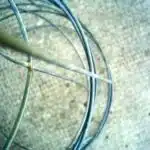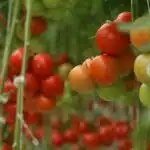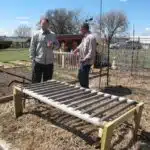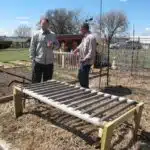Staking tomatoes is an essential task in tomato cultivation. It helps to keep the plants upright, prevent them from breaking, and increases air circulation around the foliage, which reduces diseases. Staking also promotes proper ripening of fruits and improves their quality by reducing contact with the soil. Therefore, staking should be done at an early stage of growth before the tomato plant becomes too large and difficult to manage.
There are several methods for staking tomatoes, but they all aim to provide support to the plant’s stem. The most common types of stakes used in tomato cultivation are bamboo canes, metal poles, wooden stakes, or cages made from wire mesh. Each method has its advantages and disadvantages depending on factors such as the size of the tomato plant and soil type. In this article, we will explore different ways to stake tomatoes and provide you with practical tips on how to stake your tomato plants effectively.
The Importance Of Staking Tomatoes
Tomatoes are one of the most popular fruits grown in home gardens. They are relatively easy to grow and provide a bountiful harvest with minimal effort. However, one aspect of tomato cultivation that is often overlooked is staking. While it may seem like an unnecessary step, there are numerous benefits to staking tomatoes.
One of the primary benefits of staking tomatoes is that it helps keep the fruit clean and off the ground. When tomatoes come into contact with soil, they can be more susceptible to pests and diseases. Additionally, they can become discolored or develop rot if they sit on damp soil for too long. Staking tomatoes allows them to stay upright and away from any potential hazards on the ground.
Another benefit of staking tomatoes is that it can increase yield and improve overall plant health. By providing support for the plant, staked tomatoes can grow taller and produce more fruit than un-staked plants. Staked plants also tend to have better air circulation around their leaves, reducing the risk of fungal diseases.
There are several techniques for staking tomatoes, including using wooden stakes, metal cages, or trellises made from wire or string. The best method will depend on factors such as plant size and growth habit. Regardless of which technique is used, proper staking can make a significant difference in the success of a tomato crop. In the next section, we will discuss when to stake tomatoes for optimal results.
When To Stake Tomatoes
In order to maximize the growth of tomatoes, it is important to select a stake that can support the weight of the plant and will not be easily moved by wind or other elements. The stake should be securely placed in the ground, preferably at least one foot into the soil. When pruning tomatoes, it is important to leave at least two or three leaves between each fruiting cluster and no more than 8 – 10 leaves per plant. It is also important to prune off any diseased or dead leaves and stems. Pruning should be conducted regularly to ensure even growth and reduce health problems. Finally, when harvesting tomatoes, it is important to support the fruit with one hand while gently cutting it with the other. This will ensure the health and integrity of the plant.
Choosing A Stake
Choosing the right stake is crucial when it comes to staking tomatoes. It can mean the difference between a successful crop or a disaster. There are various types of stakes available in the market, each with its own set of pros and cons. Before buying one, consider factors such as cost, durability, and ease of use.
Wooden stakes are the most popular choice for many gardeners due to their affordability. They can be easily found at garden centers or hardware stores. However, they don’t last as long as other materials and may need replacement over time. Metal stakes are more durable but can be expensive and difficult to install due to their weight. On the other hand, bamboo stakes are lightweight, easy to handle, and inexpensive but don’t offer much support for heavy fruits.
When making your decision on which stake to choose for your tomato plants, it’s essential to conduct a cost-benefit analysis. Consider the size of your garden and how many plants you plan on staking. If you have a larger space with numerous plants, then wooden stakes may not be the best option as they will need replacing frequently. Ultimately, choosing a stake that will provide adequate support for your tomato plant while considering durability and cost-effectiveness is key to ensuring a successful harvest season.
Securing The Stake
Now that you have chosen the right stake for your tomato plants, it’s time to secure them properly. Properly securing the stake is crucial in preventing damage to both the plant and its fruits. There are different types of ties available for this purpose, each with its own advantages and disadvantages.
One of the most commonly used ties is twine, which is strong and flexible. It can be easily tied around the stake and the plant without causing any damage. Velcro straps are also a popular choice as they are adjustable and reusable, making them ideal for plants that grow quickly. However, they can be more expensive than other types of ties.
Another option is using zip ties or wire, which provide a more secure hold but can cause damage if tied too tightly around the plant stem. It’s essential to check regularly to ensure that the tie isn’t cutting into the stem as it grows thicker.
To prevent damage, make sure to tie the plant loosely enough to allow for growth but tight enough to provide support. As a rule of thumb, secure the stem at two points: one near the base of the plant and another at a higher point on the stem where it first branches out. By securing your tomato plants properly with suitable types of ties, you’ll help ensure a healthy harvest season without damaging your beloved plants.
Pruning Tomatoes
When it comes to growing tomatoes, staking is an essential part of the process. However, proper staking alone isn’t enough to ensure a bountiful harvest. Pruning is another vital aspect that can help promote plant health and maximize fruit production.
Pruning benefits tomato plants by improving air circulation, decreasing the risk of disease, and directing nutrients to where they’re needed most. It also encourages the plant to focus on producing fewer but larger fruits, rather than a multitude of smaller ones.
Common mistakes when pruning tomatoes include removing too many leaves or branches, which can leave the plant vulnerable to sunburn and other damage. It’s also crucial to avoid cutting off any developing flowers or fruit-bearing stems.
Knowing when and how to prune your tomato plants can take time and experience, but it’s worth the effort in the long run. By combining proper staking techniques with regular pruning practices, you’ll be well on your way to a successful tomato harvest season.
Choosing The Right Staking Method
After determining the appropriate time to stake tomatoes, it’s essential to choose the right staking method. There are various methods of staking tomatoes, each with its pros and cons. Choosing the best method depends on factors such as plant size, location, soil type, and personal preference.
One popular method is using stakes made from different materials such as wood, bamboo, or metal. Wooden stakes are inexpensive and readily available but may not last long due to moisture damage. Metal stakes are durable but can be expensive and prone to rusting. Bamboo stakes are affordable, environmentally friendly and biodegradable but may not provide adequate support for larger tomato plants.
Another staking option is using cages made from different materials such as wire mesh or plastic. Wire cages are sturdy and can last several seasons but may be heavy and cumbersome to move around the garden. Plastic cages are lightweight and easy to move around but may not be suitable for heavier tomato varieties that require more support.
When considering the different staking materials available, it’s crucial to evaluate their benefits and drawbacks before making a final decision. However, in the subsequent section about bamboo canes, we will discuss one of the most popular choices among gardeners due to its unique advantages over other materials.
Bamboo Canes
Despite the popularity of bamboo canes as tomato stakes, there is a theory that suggests using twine instead. The claim is that twine is less expensive and easier to handle than bamboo canes. However, this theory remains controversial among gardeners and horticulturalists.
Using twine as tomato stakes requires more effort and time than simply placing bamboo canes in the soil. It involves tying knots around the plant stem and securing them to a support system. While it may seem daunting at first, some gardeners find the process therapeutic and enjoyable.
For those who prefer not to use bamboo canes or twine, there are alternatives such as metal poles or PVC pipes. These materials are durable and long-lasting, but they may be more expensive than traditional bamboo canes or twine. Ultimately, the choice of tomato stake material depends on personal preference and budget constraints.
When considering different options for tomato stakes, it is important to weigh the pros and cons of each material before making a decision. In the next section, we will explore how using metal poles as tomato stakes offers several advantages over other types of materials.
Metal Poles
Metal Poles are a popular option for staking tomatoes in the garden. They are strong, durable and provide excellent support for your tomato plants. Metal poles can also be used as a trellis system to help maintain the shape of your tomato plant. There are many different types of metal poles available on the market today, including steel, aluminum and wrought iron.
One benefit of using metal poles is their longevity. Unlike some other materials, metal poles will not rot or decay over time. This means that you can use them year after year without having to replace them. Additionally, metal poles are resistant to weathering and can withstand harsh elements like wind and rain.
Metal pole alternatives include bamboo stakes or PVC pipes which may be more affordable but lack durability and strength compared to metal poles. Some gardeners also use cages made from wire mesh instead of individual stakes when it comes to supporting tomato plants.
In the next section, we will discuss another popular option for staking tomatoes – wooden stakes. While they have their own advantages, it’s important to consider all options before making a decision on what material is best for your garden needs.
Wooden Stakes
Did you know that staking your tomato plants can increase their yield by up to 20%? It’s true! Properly staked tomato plants have better access to sunlight and air circulation, which leads to healthier plants and more bountiful harvests. When it comes to selecting stakes for your tomatoes, there are a few factors to consider.
The type of wood you choose for your stakes is important. You want a wood that is strong, durable, and resistant to rotting. Cedar and redwood are popular choices for tomato stakes because they are naturally resistant to decay and insect damage. However, these woods can be expensive. Pine is a more affordable option that is also strong and long-lasting when treated with a preservative. Bamboo is another inexpensive choice that is lightweight, easy to work with, and eco-friendly.
If wooden stakes aren’t your preference or budget, there are alternatives available. Metal stakes are sturdy and long-lasting but can be heavy and difficult to work with. Plastic stakes are lightweight and easy to install but might not be durable enough for larger tomato plants. Tomato cages made from wire mesh are another option that provides support without the need for individual stakes. In the next section, we’ll explore how to use wire mesh cages effectively for your tomato plants.
As an experienced gardener or horticulturalist knows, selecting the right type of stake for your tomato plants is essential in ensuring healthy growth and abundant harvests. While wooden stakes such as cedar or redwood may offer superior durability over cheaper options like pine or bamboo, metal or plastic may also suit specific needs based on the size of the plant being supported or personal preference regarding weight or ease of installation. If wooden or synthetic materials don’t sound appealing at all, wire mesh cages could be the perfect solution! Let’s dive into how you can use them effectively to maximize yields from your tomato garden.
Wire Mesh Cages
Wire mesh cages are a popular choice for tomato growers, due to their ease of assembly, sturdiness and low maintenance. Building wire mesh cages requires some basic tools and materials such as wire mesh, wooden stakes, and screws or zip ties. The benefits of using wire mesh cages include improved ventilation, aeration, and protection of the tomato plants from pests. Wire mesh cages also offer support to the tomato plants, ensuring they are strong enough to withstand any strong winds or heavy rain.
Building Wire Mesh Cages
Wire mesh cages are an excellent way to support and stake tomato plants. Building wire mesh cages can be done using DIY alternatives that provide a cost comparison to traditional supports. Wire mesh cages offer a sturdy and durable option for supporting tomato plants and protecting them from damage caused by wind, heavy rain, and pests.
One of the most significant advantages of building wire mesh cages is their versatility. They can be made in many different sizes and shapes depending on your tomato plant’s needs. Additionally, they are easy to install and maintain, making them an ideal option for gardeners who prefer low-maintenance gardening solutions. Furthermore, wire mesh cages can be reused year after year, making them a cost-effective solution over time.
DIY alternatives such as wooden stakes or metal pipe supports can be costly when compared to building wire mesh cages. Wooden stakes often require replacement each season due to rotting or breaking, while metal pipe supports may rust over time. In contrast, wire mesh cages offer a more durable alternative that provides long-lasting support for your tomato plants at a lower cost than traditional methods.
In conclusion, building wire mesh cages is an excellent way to support and stake tomato plants in your garden. They are versatile, easy to install and maintain, and provide sturdy protection against common issues like wind damage or pest infestations. Compared to traditional methods like wooden stakes or metal pipe supports, wire mesh cages also offer a more cost-effective solution that can save you money over time. By considering these factors when selecting supports for your tomato plants this season, you’ll enjoy healthy and robust yields throughout the growing season!
Benefits Of Wire Mesh Cages
Wire mesh cages offer many benefits to gardeners looking for a sturdy and reliable support system for their tomato plants. One of the primary advantages of using wire mesh cages is that they provide excellent ventilation for your plants, allowing air to circulate freely around them. This helps prevent moisture buildup, which can lead to fungal diseases and other problems that can damage your plants.
Another benefit of wire mesh cages is that they are easy to install and maintain. Unlike other types of supports, such as wooden stakes or metal pipes, wire mesh cages require little effort to set up and can be adjusted easily as your plants grow. They are also incredibly durable and can last for years with minimal maintenance, making them a cost-effective solution for gardeners on a budget.
When compared to DIY alternatives such as wooden stakes or metal pipe supports, wire mesh cages offer several advantages that make them an attractive option for supporting tomato plants. Unlike wooden stakes, which can rot or break over time, wire mesh cages are made from sturdy materials that can withstand the elements and protect your plants from wind damage or pest infestations. Additionally, wire mesh cages are more versatile than metal pipe supports, allowing you to customize their size and shape to meet the needs of your specific tomato plant varieties.
Overall, the benefits offered by wire mesh cages make them an ideal choice for gardeners looking for a reliable support system for their tomato plants. By using this type of support structure in your garden, you can enjoy healthy yields of delicious tomatoes while minimizing the risk of common problems like fungal diseases or pest infestations. So if you’re looking for an effective and cost-efficient way to support your tomato plants this season, consider using wire mesh cages as an alternative to traditional methods like wooden stakes or metal pipe supports.
How To Set Up Stakes
Wire mesh cages are a popular method for supporting tomato plants, but another option is to use stakes. Staking tomatoes involves using a single, sturdy stake for each plant and tying the stem to the stake as it grows. This provides support and keeps the fruit off the ground, reducing the risk of disease and pests.
Types of materials that can be used for staking tomatoes include wood, bamboo, metal or plastic stakes. Wood stakes are durable and affordable but may rot over time. Bamboo stakes are lightweight but may not be strong enough to support larger plants. Metal or plastic stakes are long-lasting but may be more expensive than other options.
Cost of staking can vary depending on the size and number of plants being supported, as well as the type of material used. However, staking can be a cost-effective option in comparison to purchasing wire mesh cages or other supports. Additionally, using stakes allows for greater flexibility in terms of spacing between plants and can make it easier to access the tomato plants for pruning and harvesting.
Transition: Now that you have selected your preferred material for staking tomatoes and know how much it will cost you, it’s time to learn how to properly tie the tomato plant to the stake without damaging it.
Tying The Tomato Plant
As your tomato plants grow taller and heavier, they will require support to prevent their stems from breaking. Tying the tomato plant is a crucial step in staking tomatoes. It ensures that the plant remains upright and healthy until harvest time.
Tying techniques vary depending on the type of stake you are using. If you are using a single stake, then tying the plant in a spiral fashion around the stake is recommended. This technique allows for even distribution of weight along the length of the stake, preventing any breakage. Another tying technique involves using twine or soft string to tie the plant to the stake at regular intervals.
Materials used for tying should be soft and flexible enough to avoid damaging the plant’s stem while still providing adequate support. Twine made from natural fibers such as jute or sisal is an excellent choice as it decomposes easily after harvest time and does not harm the environment. Soft string made from cotton or nylon can also be used, but it needs to be checked regularly to ensure that it does not cut into the stem as it grows thicker.
Proper tying techniques and materials used are essential in ensuring that your tomato plants remain healthy throughout their growth cycle. In our next section, we will discuss how pruning can further enhance your tomatoes’ health while staking them properly.
Pruning For Better Staking
To ensure successful staking of tomato plants, it is essential to adopt pruning techniques that will encourage the plant’s growth in an upward direction. Pruning involves removing unwanted and unnecessary parts of the plant, such as suckers, which are the small branches that grow from the main stem. Suckers often divert nutrients and energy away from the main plant and should be removed regularly to promote healthy growth. Using training methods like staking or caging coupled with proper pruning can help keep tomato plants off the ground, prevent diseases, and increase yields.
One effective way to prune a tomato plant is by using the single stem technique. This method involves removing all suckers that emerge from the main stem except for one. The chosen sucker will eventually grow into a new stem, which can be tied to a stake or trained around a cage. This technique increases airflow and light penetration throughout the plant, reducing humidity levels that promote fungal diseases. It also helps reduce fruit rot and makes harvesting much easier.
Another pruning technique is to pinch off the top of the main stem once it reaches a certain height; this helps redirect energy to growing side stems rather than upward growth. These lateral branches then require support through staking or caging systems to ensure they do not break under the weight of mature fruits. Proper pruning techniques play a crucial role in ensuring healthy tomato plants that yield an abundance of delicious fruits come harvest time.
Transition: With proper pruning techniques in place, it is time to focus on tips for staking larger plants for optimal growth potential.
Tips For Staking Larger Plants
When it comes to staking larger plants such as tomatoes, there are a few tips and tricks that can help ensure their success. First and foremost, it is essential to choose the right type of stakes or support structures for your plants. This will depend on the size and weight of your plants, as well as the growing conditions in your particular garden.
One important consideration when staking larger plants is supporting branches. As tomato plants grow, they will produce more and more branches that will need support to prevent them from breaking under the weight of fruit or strong winds. This can be accomplished with additional stakes or trellises, or by tying branches together with twine or other materials.
Another critical factor to consider when staking larger plants is wind protection. Strong winds can damage plants by breaking stems and leaves, so it’s essential to provide some form of windbreak around your garden area. This could be achieved through the use of tall fences or walls, planting shrubs or trees around the perimeter of your garden, or using temporary windbreaks like fabric screens.
- Use sturdy stakes or support structures
- Tie up supporting branches regularly
- Provide a windbreak for protection
- Monitor for signs of stress such as wilting
In conclusion, staking larger plants requires careful consideration to ensure their success. By selecting appropriate support structures, regularly tying up supporting branches, providing wind protection, and monitoring for signs of stress like wilting, you can help your plants thrive. Next up we’ll discuss staking in containers and how it differs from outdoor gardening methods.
Staking In Containers
As we learned in the previous section, staking larger plants can help maintain their structure and support their growth. However, staking is not limited to plants grown in traditional garden beds. Container gardening has become increasingly popular, especially for those with limited space or poor soil quality. Staking tomatoes in containers can be a great way to ensure they grow tall and strong.
When selecting a container for your tomatoes, it’s important to choose one that is deep enough for the roots to grow and wide enough to provide stability. A 5-gallon container is a good place to start for a single tomato plant. Make sure the container has drainage holes to prevent water from sitting at the bottom, which could lead to root rot.
Soil preparation is also key when growing tomatoes in containers. Use a high-quality potting mix that is well-draining and nutrient-rich. Avoid using garden soil as it may contain diseases or pests that can harm your plants. Consider adding organic matter such as compost or aged manure to enrich the soil and promote healthy growth.
To maintain staked tomatoes in containers, regular watering and fertilization are crucial. Water your plants deeply when the top inch of soil feels dry, but be careful not to overwater as this can lead to root rot. Fertilize your plants every two weeks with a balanced fertilizer that contains equal parts nitrogen, phosphorus, and potassium. Prune any suckers that develop between the main stem and branches as these can divert energy away from fruit production.
In order to keep your staked tomato plants healthy and productive, proper maintenance is essential. By following these guidelines for container selection and soil preparation, you’ll be on your way to growing delicious tomatoes in no time!
Maintaining Staked Tomatoes
Maintaining staked tomatoes is essential to ensure that they grow healthy and produce a bountiful harvest. Watering frequency is a crucial aspect of maintaining staked tomatoes. During the growing season, tomato plants require 1-2 inches of water per week, either through rainfall or watering. It’s best to water deeply and less frequently rather than watering shallowly and more often to encourage deep root growth. Consistent watering is essential in preventing blossom end rot, which can occur when the soil is too dry.
Fertilizer application is another vital aspect of maintaining staked tomatoes. Tomatoes are heavy feeders and require regular fertilization throughout the growing season. A balanced fertilizer with an N-P-K ratio of 10-10-10 or 5-10-10 should be applied every two to three weeks during the growing season. However, it’s crucial not to over-fertilize as this can lead to excess foliage growth at the expense of fruit production.
Properly maintaining staked tomatoes can help prevent common issues such as disease, pests, and other problems that may affect plant growth and health. In the subsequent section, we will discuss these issues in detail and provide solutions on how to troubleshoot them effectively. By following these maintenance practices, gardeners can enjoy a bountiful harvest of fresh, juicy tomatoes straight from their backyard garden.
Troubleshooting Common Issues
Maintaining staked tomatoes is essential to ensure the plant’s health and fruit yield. Regular pruning is necessary to remove excess foliage, leading to better air circulation and sun exposure for the fruits. Additionally, it helps prevent the spread of diseases that can damage the plant or reduce its productivity. When staking tomatoes, it’s crucial to inspect them regularly for any signs of pests or diseases.
Identifying pests is one of the most critical aspects of maintaining a healthy tomato plant. Common tomato pests include aphids, whiteflies, spider mites, and hornworms. These pests can cause significant damage to your plant if not detected early enough. You can use insecticidal soap or neem oil to control these pests.
Preventing disease is also crucial when maintaining staked tomatoes. Tomato plants are susceptible to various diseases such as blight, blossom end rot, and fusarium wilt. To prevent disease from attacking your plants, ensure you water them at their roots instead of overhead watering. Overhead watering causes fungal growth on leaves that can lead to severe diseases. Also, rotate crop planting in different areas every year and maintain proper spacing between plants.
Harvesting tomatoes from staked plants requires care and attention not to damage the fruits or the plant itself. Start by checking for ripeness by looking for a deep color change in each fruit or giving it a gentle squeeze; ripe fruits will feel slightly soft but not mushy. Then use clean scissors or pruning shears to cut the stem just above each fruit’s base carefully. Avoid pulling ripe fruits off the vine as this may cause damage or breakage to both the fruit and plant stem.
Harvesting Tomatoes From Staked Plants
After staking tomatoes, the next step is harvesting. It is important to know when the tomatoes are ready for harvest. Generally, they should be harvested when they are fully ripe and have reached their mature color. This can extend from red to yellow, depending on the variety of tomato.
When harvesting, it is important to prevent splitting. Tomatoes tend to split when they receive sudden changes in water intake or temperature. To prevent this, make sure that the plants receive consistent watering and avoid sudden increases or decreases in water intake. Additionally, handle the tomatoes with care during harvest to avoid any damage that may lead to splitting.
Maximizing yield is also a crucial aspect of harvesting tomatoes from staked plants. It is recommended to harvest regularly once the fruits have ripened. This encourages further fruit production and ensures that no fruits go overripe on the plant, which can reduce overall yield. By following these practices, you can ensure a bountiful harvest from your staked tomato plants while preventing splitting and maximizing yield.
As a gardener or horticulturalist, it is important to remember that proper care and attention will reward you with healthy and fruitful plants. When it comes to harvesting tomatoes from staked plants, preventing splitting and maximizing yield are two key factors that can make all the difference. With consistent watering and regular harvesting at peak ripeness, you can enjoy a successful tomato harvest season without any issues.
Conclusion
Staking tomatoes is an important aspect of growing healthy and productive plants. It helps to support the weight of the plant, prevent breakage, and improve air circulation around the foliage. Staking should be done at the right time, using a suitable method to avoid damaging the roots or stem of the plant.
When staking tomatoes, there are various methods to choose from, including bamboo canes, metal poles or stakes in containers. Each method has its advantages and disadvantages depending on factors such as plant size, location and weather conditions. Proper maintenance of staked tomatoes is essential to ensure maximum yields and longevity of the plants.
Common issues that may arise include pests, diseases, nutrient deficiencies or improper pruning techniques. However, these can be easily resolved with proper identification and treatment strategies. Harvesting ripe tomatoes from staked plants is a rewarding experience that requires careful handling to avoid damage to the fruit.
In conclusion, staking tomatoes is an integral part of successful tomato gardening that ensures optimal plant growth and fruit production. By selecting a suitable staking method and maintaining proper care for your plants throughout their growth cycle, you can achieve a bountiful harvest that will delight both your taste buds and those of your family and friends. Remember: A green thumb takes patience but reaps a fruitful harvest!
Image Credits
- “stakes for the tomatos” by woodleywonderworks (featured)





























